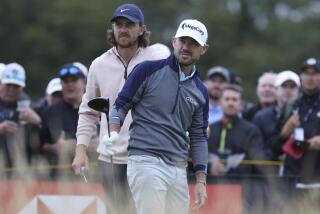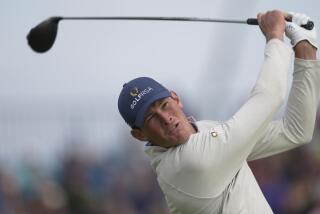U.S. OPEN GOLF CHAMPIONSHIP : Strange Goings On as 2 End Tied
BROOKLINE, Mass. â For Curtis Strange, Sunday was a day for the putt he couldnât make, the lead he couldnât hold and the U.S. Open he couldnât win.
And the tournament that wouldnât end after its shelf life of 4 days and 72 holes expired, gets another day and 18 more holes today, all because Strange lost his one-shot lead with two holes to go, shot one-over-par 72 and fell into a playoff with Great Britainâs Nick Faldo, Lord of the two-putt on either side of the ocean.
Strange and Faldo, who finished four rounds at six-under-par 278, will break out their golf bags for another 18-hole tour of The Country Club today to find out which one is finally going to win this thing. Truthfully, it should never have come to this.
As he stood on the 17th tee, Strange had a one-shot lead over Faldo, who had parred the first 14 holes before a rare birdie and an equally rare bogey dropped him back.
Faldo was the only player left with a chance to beat Strange. All the other challengers, the expected ones such as Scott Simpson, Larry Mize and Bob Gilder and the surprises such as Steve Pate, D.A. Weibring and Mark OâMeara, had disappeared into the warm, sunny afternoon.
Strange got on the green of the par-4 381-yard hole in two. He said he was 15 feet from the hole, but he must have meant that was the distance his putt covered. Strange stroked it and the ball rolled 6 or 7 feet past the hole.
When Strange two-putted from there, he had a bogey and a playoff on his hands.
Because both Strange matched Faldo with a par 4 on the 18th, which was not without its own tension, it was clear that Strangeâs first victory in a major was prevented, or maybe just delayed, by a decidely minor putt.
The 17th green is newly planted and Strange was fooled by its speed.
âI really didnât hit it very hard at all,â he said. âIt went a hell of a lot faster than I thought it would.
âIt got away from me. Itâs one of those putts where Iâd like to take a drop and try it again to see if I could get it closer to the hole.â
Faldo, the 1987 British Open champion, won his countryâs biggest tournament with 18 consecutive pars. Faldo employed much the same tactics Sunday and very nearly won again with a steady if unspectacular round of par 71.
âI was sort of grinding it out,â Faldo, who didnât miss a fairway all day, said.
What he actually wanted to do, Faldo said, was try for birdies and avoid the kind of grilling he got for his victory for par and for Britain last summer at Muirfield.
âThere was certainly no game plan trying to par every hole,â Faldo said. âI knew you guys would give me a wonderful time for 18 pars.â
Neither Faldo nor Strange has ever played an 18-hole playoff, which is unique to the U. S. Open. The last U.S. Open playoff was in 1984 at Winged Foot when Fuzzy Zoeller beat Greg Norman by eight strokes.
Early in the fourth round, the chances of a playoff looked good. Only the names of the participants were in doubt.
Strange got off on the wrong foot with bogeys at 2 and 3 when he missed short putts. Faldo, parring along, took the lead. Playing one group ahead was Simpson, but he bogeyed 3 and double-bogeyed 4 to fall three shots back.
Weibring jumped up with a 20-foot birdie putt on No. 4 and followed it with an 18-foot birdie putt on No. 5 which put him 6-under par and tied him with Faldo for the lead.
Mize double-bogeyed No. 5 and dropped to 3-under par with Simpson, Mark OâMeara, Fred Couples and Paul Azinger and Lanny Wadkins, who were making a late rush.
Peter Jacobson made the latest rush of all. Beginning the day nine-over par, Jacobson shot a 64, but he had started too far back. The tournament was left to the others.
When Pate eagled No. 9 by rolling in a 30-footer and came right back with a birdie on the 10th, it really got crowded near the top. There were 10 players within three shots of each other.
One by one, they played themselves out of contention. Gilder finished with a 75, Simpson a 74, Mize a 76, Weibring a 72 and Couples a 73. Once only one shot off the lead, OâMeara bogeyed the last hole, closed out at 71 and missed a chance for finishing alone in third.
Pate, Weibring, and OâMeara tied for third at 280, two shots off the lead, and made $41,370 apiece. Paul Azinger was another stroke back after a round of 66 and matched Simpson at 281.
So the Open was left to Faldo and Strange by the time they approached the 17th tee. Faldo assessed his chances.
âBad and awful,â he said.
But that was before Strangeâs bogey, which surprised Faldo.
âI thought he was going to hole that putt,â Faldo said.
Strange used similar language when he spoke of how he played.
âI played horrible and I putted just about as bad,â Strange said.
The trouble was he couldnât make enough putts. Besides the short ones he missed for the two yearly bogeys, Strange almost stopped a 4-footer short on No. 5 that would have been a birdie and two-putted from 6 feet on 14 for another par.
âI did have opportunities to put everybody away,â he admitted.
As the gallery closed in behind them, all that stood between Strange and Faldo and a playoff was the 18th hole, the 438-yard par 4 with the bunker that guards the front of the green.
Strange found it with his 7-iron second shot and Faldo put his ball 25 feet from the hole to the right of the cup. Faldo stopped his putt 18 inches from the hole. Strange got a little closer. He came out of the sand to within 12 inches.
When they both made their putts for par, the playoff was on. Strange knew he could have avoided it.
âI say I played bad, but I guess what I remember more than anything else are the putts I missed,â he said. âJust terrible.â
âI was more nervous (than other days) . . . that very well could be,â Strange said. âBut I putt better when Iâm nervous. It might be because it was the U.S. Open. Maybe not.â
More to Read
Go beyond the scoreboard
Get the latest on L.A.'s teams in the daily Sports Report newsletter.
You may occasionally receive promotional content from the Los Angeles Times.










